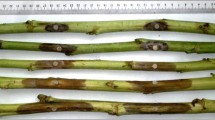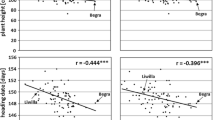Abstract
Sclerotinia stem rot, caused by fungus Sclerotinia sclerotiorum, is one of the most devastating diseases in rapeseed (Brassica napus L.). We report the identification of Quantitative trait loci (QTL) involved in the resistance to S. sclerotiorum in two segregating populations of DH lines: the HUA population, derived from a cross between a partially resistant Chinese winter line (Hua dbl2) and a susceptible European spring line (P1804); and the MS population, derived from a partially resistant French winter cultivar (Major) and a susceptible Canadian spring cultivar (Stellar). A petiole inoculation technique and two scoring methods, days to wilt (DW) and stem lesion length (SLL), were used for the resistance assessment. A total of eight genomic regions affecting resistance were detected in the HUA population, with four of these regions affecting both measures of resistance. Only one region, which affected both measurements, was detected in the MS population. Individual QTL explained 6–22% of the variance. At five of the QTL from both populations, alleles from the resistant parent contributed to the resistance. QTL on N2 from the HUA population had the highest LOD score and R 2 value and was detected for SLL in the first evaluation. The N12 resistance allele in Hua dbl2 was detected in a region containing a homeologous non-reciprocal transposition (HNRT) from the resistance-containing portion of N2. This result suggests that QTL in the N12.N2 HNRT enhanced the resistance of Hua dbl2 by increasing the dosage of resistance genes. The relationship of QTL from different genetic backgrounds and their associations with other agronomic traits are discussed.


Similar content being viewed by others
References
Arahana VS, Graef GL, Specht JE, Steadman JR, Eskridge KM (2001) Identification of QTLs for resistance to Sclerotinia sclerotiorum in soybean. Crop Sci 41:180–188
Basten CJ, Weir BS, Zeng ZB (2002) QTL Cartographer, Version 1.16. Department of Statistics, North Carolina State University, Raleigh
Bert PF, Jouan I, Tourvieille de Labrouhe D, Serre F, Nicolas P, Vear F (2002) Comparative genetic analysis of quantitative traits in sunflower (Helianthus annuus L.) 1. QTL involved in resistance to Sclerotinia sclerotiorum and Diaporthe helianthi. Theor Appl Genet 105:985–993
Doerge RW, Churchill GA (1996) Permutation tests for multiple loci affecting a quantitative character. Genetics 142:285–294
Ferreira ME, Williams PH, Osborn TC (1994) RFLP mapping of Brassica napus using doubled haploid lines. Theor Appl Genet 89:615–621
Ferreira ME, Satagopan J, Yandell BS, Williams PH, Osborn TC (1995a) Mapping loci controlling vernalization requirement and flowering time in Brassica napus. Theor Appl Genet 90:727–732
Ferreira ME, Rimmer SR, Williams PH, Osborn TC (1995b) Mapping loci controlling Brassica napus resistance to Leptosphaeria maculans under different screening conditions. Phytopathology 85:213–217
Hartman GL, Gardner ME, Hymowitz T, Naidoo GC (2000) Evaluation of perennial Glycine species for resistance to soybean fungal pathogens that cause Sclerotinia stem rot and sudden death syndrome. Crop Sci 40:545–549
Hoffman DD, Diers BW, Hartman GL, Nickell CD, Nelson RL, Pedersen WL, Cober ER, Graef GL, Steadman JR, Grau CR, Nelson BD, del Rio LE, Helms T, Anderson T, Poysa V, Rajcan I, Stienstra WC (2002) Selected soybean plant introductions with partial resistance to Sclerotinia sclerotiorum. Plant Dis 86:971–980
Kim HS, Hartman GL, Manandhar JB, Graef GL, Steadman JR, Diers BW (2000) Reaction of soybean cultivars to Sclerotinia stem rot in field, greenhouse, and laboratory evaluations. Crop Sci 40:665–669
Knapp SJ, Stroup WW, Ross WW (1985) Exact confidence intervals for heritability on a progeny mean basis. Crop Sci 25:192–194
Kole C, Thormann CE, Karlsson BH, Palta JP, Gaffney P, Yandell B, Osborn TC (2002) Comparative mapping of loci controlling winter survival and related traits in oilseed Brassica rapa and B. napus. Mol Breed 9:201–210
Kolkman JM, Kelly JD (2003) QTL conferring resistance and avoidance to white mold in common bean. Crop Sci 43:539–548
Mariani C, Gossele V, de Beuckeleer M, de Block M, Goldberg RB, de Greef W, Leemans J (1992) A chimeric ribonuclease-inhibitor gene restores fertility to male-sterile plants. Nature 357:384–387
Mestries E, Gentzbittel L, de Labrouhe DT, Nicolas P, Vear F (1998) Analyses of quantitative trait loci associated with resistance to Sclerotinia sclerotiorum in sunflowers (Helianthus annuus L.) using molecular markers. Mol Breed 4:215–226
Miklas PN, Johnson WC, Delorme R, Gepts P (2001) QTL conditioning physiological resistance and avoidance to white mold in dry bean. Crop Sci 41:309–315
Oilcrop Research Institute, Chinese Academy of Sciences (1975) Sclerotinia disease of oilseed crops. Agriculture Press, Beijing
Osborn TC, Kole C, Parkin IA, Sharpe AG, Kuiper M, Lydiate DJ, Trick M (1997) Comparison of flowering time genes in Brassica rapa, B. napus and Arabidopsis thaliana. Genetics 146:1123–1129
Osborn TC, Butruille DV, Sharpe AG, Pickering KJ, Parkin IAP, John PS, Lydiate DJ (2003) Detection and effects of a homoeologous reciprocal transposition in Brassica napus. Genetics 165:1569–1577
Parkin IAP, Sharpe AG, Keith DJ, Lydiate DJ (1995) Identification of A and C genomes of amphidiploid Brassica napus (oilseed rape). Genome 38:1122–1131
Purdy LH (1979) Sclerotinia sclerotiorum: history, diseases and symptomatology, host range, geographic distribution and impact. Phytopathology 69:887–890
Quijada PA (2003) Introgression of germplasm from winter into spring Brassica napus: detection and confirmation of quantitative trait loci. PhD Thesis. University of Wisconsin.
Song KM, Osborn TC (1992) Polyphyletic origins of Brassica napus – new evidence based on organelle and nuclear RFLP analyses. Genome 35:992–1001
Thormann CE, Romero J, Mantet J, Osborn TC (1996) Mapping loci controlling the concentrations of erucic and linolenic acids in seed oil of Brassica napus L. Theor Appl Genet 93:282–286
Toroser D, Thormann CE, Osborn TC, Mithen R (1995) RFLP mapping of quantitative trait loci controlling seed aliphatic-glucosinolate content in oilseed rape (Brassica napus L.). Theor Appl Genet 91:802–808
U N (1935) Genome analysis in Brassica with special reference to the experimental formation of B. napus and peculiar mode of fertilization. Jpn J Bot 7:384–452
Udall JA (2003) A genetic study of oilseed Brassica napus L.: mapping chromosome rearrangements and quantitative trait loci. PhD thesis. University of Wisconsin-Madison
Udall JA, Quijada PA, Polewicz H, Vogelzang R, Osborn TC (2004) Phenotypic effects of introgressing Chinese winter and resynthesized Brassica napus L. germplasm into hybrid spring Canola. Crop Sci 44:1990–1996
Udall JA, Quijada PA, Osborn TC (2005) Detection of chromosomal rearrangements derived from homoeologous recombination in four mapping populations of Brassica napus L. Genetics 169:967–979
Vuong TD, Hartman GL (2003) Evaluation of soybean resistance to Sclerotinia stem rot using reciprocal grafting. Plant Dis 87:154–158
Wegulo SN, Yang XB, Martinson CA (1998) Soybean cultivar responses to Sclerotinia sclerotiorum in field and controlled environment studies. Plant Dis 82:1264–1270
Zhao J, Meng J (2003a) Genetic analysis of loci associated with partial resistance to Sclerotinia sclerotiorum in rapeseed (Brassica napus L.). Theor Appl Genet 106:759–764
Zhao J, Meng J (2003b) Detection of loci controlling seed glucosinolate content and their association with Sclerotinia resistance in Brassica napus. Plant Breed 122:19–23
Zhao J, Peltier AJ, Meng J, Osborn TC, Grau CR (2004) Evaluation of sclerotinia stem rot resistance in oilseed Brassica napus using a petiole inoculation technique under greenhouse conditions. Plant Dis 88:1033–1039
Zhou LC, Yu Q, Liu SY, Zhou BW (1994) Evaluation of Sclerotinia resistance in rapeseed. Chin Oilseed Crop (supplement) 4:69–72
Acknowledgements
We thank Dr. Glen Hartman, USDA/ARS, University of Illinois for providing the S. sclerotiorum isolate. This work was funded by the USDA Sclerotinia Initiative.
Author information
Authors and Affiliations
Corresponding author
Additional information
Communicated by C. Möllers
Rights and permissions
About this article
Cite this article
Zhao, J., Udall, J.A., Quijada, P.A. et al. Quantitative trait loci for resistance to Sclerotinia sclerotiorum and its association with a homeologous non-reciprocal transposition in Brassica napus L. . Theor Appl Genet 112, 509–516 (2006). https://doi.org/10.1007/s00122-005-0154-5
Received:
Accepted:
Published:
Issue Date:
DOI: https://doi.org/10.1007/s00122-005-0154-5




